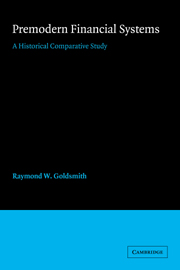Book contents
- Frontmatter
- Contents
- List of tables
- Preface
- 1 Introduction
- 2 The financial systems of the ancient Near East
- 3 The financial system of Periclean Athens
- 4 The financial system of Augustan Rome
- 5 The financial system of the early Abbasid caliphate
- 6 The financial system of the Ottoman Empire at the death of Suleiman I
- 7 The financial system of Mughal India at the death of Akbar
- 8 The financial system of early Tokugawa Japan
- 9 The financial system of Medici Florence
- 10 The financial system of Elizabethan England
- 11 The financial system of the United Provinces at the Peace of Münster
- 12 Similarities and differences
- Notes
- Bibliography
- Index
2 - The financial systems of the ancient Near East
Published online by Cambridge University Press: 05 March 2012
- Frontmatter
- Contents
- List of tables
- Preface
- 1 Introduction
- 2 The financial systems of the ancient Near East
- 3 The financial system of Periclean Athens
- 4 The financial system of Augustan Rome
- 5 The financial system of the early Abbasid caliphate
- 6 The financial system of the Ottoman Empire at the death of Suleiman I
- 7 The financial system of Mughal India at the death of Akbar
- 8 The financial system of early Tokugawa Japan
- 9 The financial system of Medici Florence
- 10 The financial system of Elizabethan England
- 11 The financial system of the United Provinces at the Peace of Münster
- 12 Similarities and differences
- Notes
- Bibliography
- Index
Summary
The following chapters try to connect the financial system of a country at a given date, that is, its financial instruments and its financial institutions, to its economic infrastructure of national product and national wealth. This is not possible for the ancient Near East, which here includes Mesopotamia and Egypt from the third to the middle of the first millennium b.c. The data are so deficient that hardly anything can be said in quantitative terms about the economic infrastructure, and that description must be limited to the monetary system and to whatever financial instruments and institutions existed. In view of the stability of these economies it is not necessary, nor possible, to try to determine trends in the financial superstructure.
These countries and millennia were essentially nonmonetized, though metals were used to a limited extent in pensatory payments and in the incurrence and discharge of debts, but were never coined, an innovation introduced late in the seventh century B.C. in western Asia Minor. The great majority of the population lived on and from the land. Most rents and taxes to secular and religious authorities were paid in commodities or in labor services. These countries thus had dual economies: A predominant nonmonetized sector of the type of a command economy and a smaller though slowly increasing monetized sector that was important in interlocal domestic trade and predominated in foreign trade.
- Type
- Chapter
- Information
- Premodern Financial SystemsA Historical Comparative Study, pp. 10 - 15Publisher: Cambridge University PressPrint publication year: 1987

